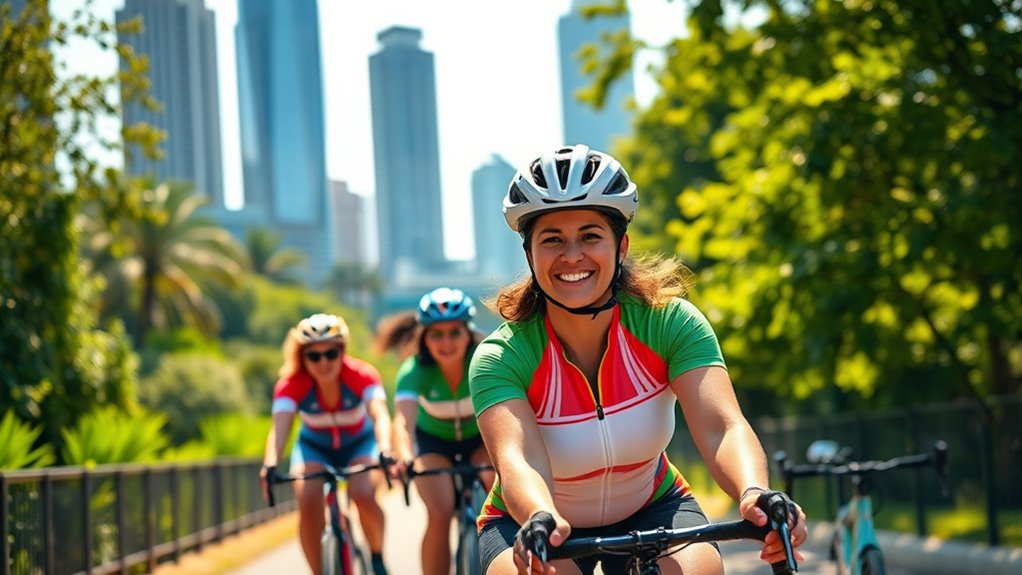Women in cycling are breaking barriers by challenging stereotypes, advocating for equal resources, and inspiring future generations. Pioneers like Beryl Burton and Marianne Vos set inspiring standards, while community support and mentorship help build confidence. Events like the Tour de France Femmes highlight growth and opportunity. By promoting inclusive infrastructure and awareness, women continue to push boundaries. Keep exploring to discover how these changes are shaping a more equal and empowered cycling world.
Key Takeaways
- Women actively challenge stereotypes and promote inclusive cycling environments through designated zones and awareness campaigns.
- Trailblazing female athletes like Beryl Burton and Marianne Vos inspire future generations and celebrate milestones in women’s cycling.
- Tailored training, resilience, and goal-setting help women overcome physical and mental barriers in cycling.
- Community mentorship and support systems foster confidence, shared experiences, and ongoing participation among women cyclists.
- Growing women’s cycling events and advocacy efforts promote gender equality, improve access, and highlight female athletes’ achievements.
Challenging Stereotypes and Cultural Norms
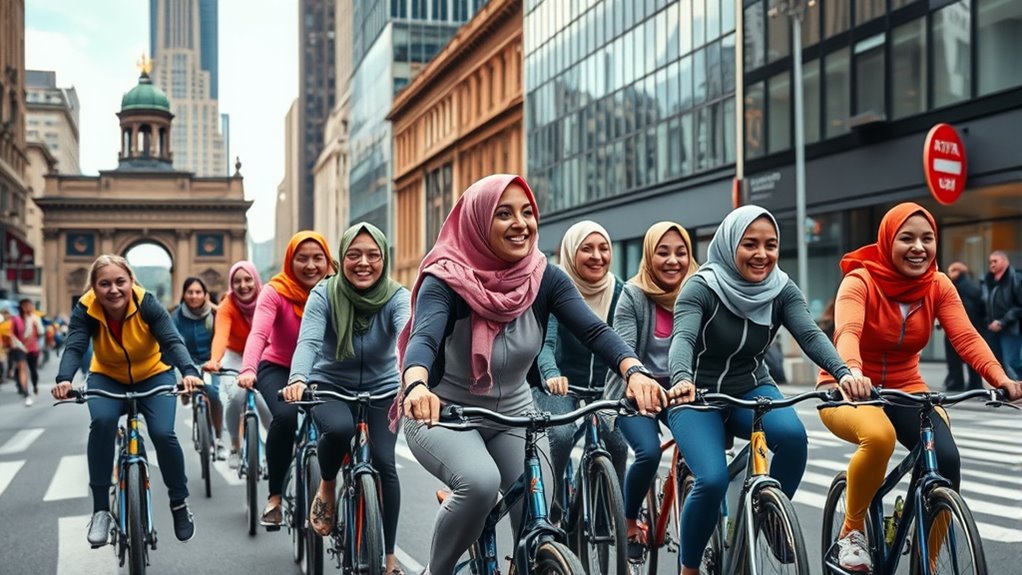
Although cycling has traditionally been viewed as a male-dominated activity, women are challenging these stereotypes and breaking cultural norms every day. You understand that gender stereotypes often discourage women from cycling, making them feel out of place or unsafe. Creating designated zones for women or beginners can also help foster a more welcoming environment. Cultural barriers, like societal expectations or lack of access, can also hinder participation. By choosing to ride, you defy these norms and inspire others to do the same. Your actions show that cycling isn’t just for men; it’s a sport and mode of transportation for everyone. Additionally, contrast ratios in equipment and environments can influence the visibility and safety of women cyclists, further encouraging participation. Recognizing the importance of inclusive infrastructure, more communities are investing in safer bike lanes and facilities that support diverse riders. Research indicates that cultural acceptance plays a significant role in increasing women’s participation in cycling activities. Promoting awareness of gender equality can help challenge deeply rooted societal biases and foster a culture of inclusivity. As more women take up cycling, they reshape perceptions and create a more inclusive environment. Your courage and persistence help dismantle barriers and prove that gender should never limit participation or passion.
Pioneers Who Changed the Game

Many women have paved the way for change in cycling, challenging conventions and inspiring future generations. These pioneers pushed boundaries, advocating for gender equality in sport and driving sports innovation. They broke records, challenged stereotypes, and expanded opportunities for women in cycling. Their efforts transformed perceptions, proving that women belong in every race and competition. Their legacy encourages you to continue pushing for progress and equality. Here’s a quick look at some influential figures:
| Pioneer | Contribution |
|---|---|
| Beryl Burton | Dominated women’s cycling, inspiring gender equality |
| Jeannie Longo | Innovated training techniques, broke records |
| Marianne Vos | Continues to push sports innovation and equality |
Their stories remind us that change starts with trailblazers who refuse to accept limits. Leadership skills play a vital role in inspiring others and fostering ongoing progress in the sport. Developing a growth mindset can empower aspiring cyclists to overcome obstacles and pursue excellence. Recognizing the importance of gender equality in sports is essential to creating a more inclusive future for all athletes. Embracing the use of essential oils for recovery and health can further support athletes in their journeys toward success. Additionally, advancements like the Snapdragon 8 Gen 3 are enhancing mobile technology, which can indirectly benefit athletic training and performance monitoring through improved devices.
Overcoming Physical and Mental Barriers
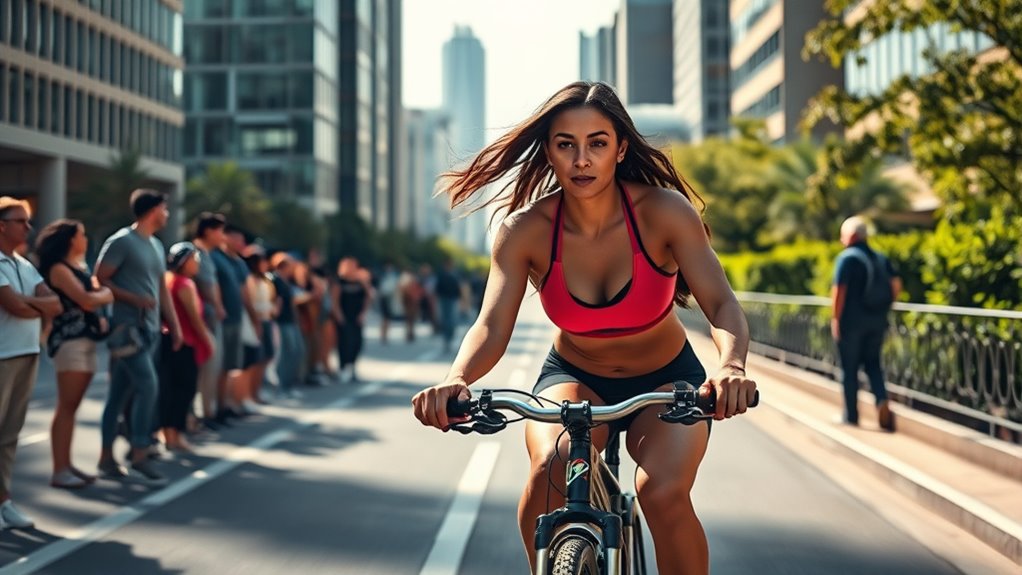
When facing physical and mental barriers in cycling, perseverance and mindset are your strongest tools for overcoming them. Developing tailored training programs can help you build strength gradually, making challenging rides more manageable. Incorporating growth mindset principles can also shift your perspective to see setbacks as opportunities for improvement. Practicing self-reflection and cultivating resilience through persistence can empower you to stay motivated during setbacks. Personal empowerment techniques like setting SMART goals and engaging in continuous learning also support sustained progress. Additionally, understanding the importance of consistent training can help you establish routines that foster steady improvement. Recognizing progress tracking methods can provide valuable feedback and motivation along your journey.
Remember, motivational stories from women who’ve faced similar obstacles can inspire you to push through doubts and setbacks. Focus on setting realistic goals and celebrating small victories, which boost confidence and resilience.
It’s normal to encounter moments of self-doubt or fatigue, but your commitment to consistent training and positive self-talk keeps you moving forward. Overcoming these barriers isn’t about perfection; it’s about persistence.
With determination, you’ll find that what once seemed insurmountable becomes part of your journey toward greater strength and confidence in cycling.
The Role of Mentorship and Community Support
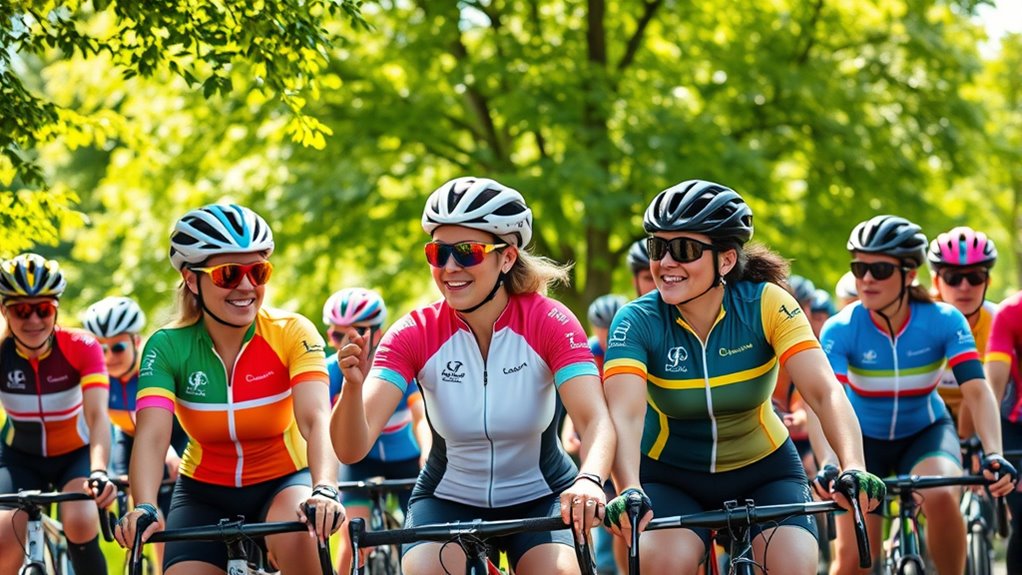
Building a strong support system can substantially enhance your cycling journey, especially when facing challenges alone. Mentorship programs connect you with experienced women who can offer guidance, encouragement, and practical advice, helping you develop skills and confidence. Recognizing recurring angel numbers can serve as motivating signs that you’re on the right path and encourage persistence through obstacles.
Community initiatives create a sense of belonging, allowing you to share experiences and celebrate progress together. These networks foster motivation and provide safe spaces to ask questions or seek help, making cycling more accessible and enjoyable. Incorporating educational toys into community programs can further empower women by developing new skills and fostering confidence in various areas beyond cycling. Additionally, understanding how remote work can offer flexible schedules enables women to dedicate more time to their cycling passions and community involvement.
When you participate in community rides or mentorships, you not only gain knowledge but also build meaningful relationships that can last a lifetime. Supporting one another empowers women to push past barriers and stay committed to their cycling goals. Engaging in community engagement can also help create a more inclusive environment that encourages diverse participation and innovation.
Additionally, fostering a culture of creativity and innovation within these communities can inspire new ideas and approaches to problem-solving, enhancing overall engagement and progress.
Women’s Cycling Events and Competitions

You’ll notice that women’s cycling events have gained recognition through notable races around the world, inspiring many to participate. Participation trends are steadily increasing, showing more women are taking up competitive cycling than ever before. These developments highlight how women’s races are shaping the future of the sport. As the sport continues to grow, initiatives promoting gender equality in sports are becoming more prominent, encouraging greater participation and support for women athletes. Additionally, the growing popularity of crochet styles for locs and similar creative outlets exemplifies how women are embracing diverse interests that promote empowerment and self-expression.
Notable Women’s Races
Some of the most exciting moments in women’s cycling happen during its premier races and competitions, where top athletes showcase their skills and determination. These races often utilize AI-driven insights to analyze performance and strategize effectively, elevating the level of competition. Events like the Tour de France Femmes, Giro Rosa, and the UCI Road World Championships have rich women’s race histories that highlight the sport’s legacy. These races attract fierce competition and celebrate notable race winners who’ve made history through their exceptional performances. Additionally, the growing presence of women’s cycling events has helped promote gender equality in the sport and inspired more women to participate at all levels.
For you, understanding these races reveals the evolution of women’s cycling and the incredible athletes who’ve broken barriers. Each race offers a chance to witness the skill, perseverance, and passion that define women’s cycling. These events continue to inspire new generations and push the sport toward greater recognition and equality.
Growing Participation Trends
Have you noticed how women’s cycling events are growing in popularity worldwide? More women are participating in races and competitions, driven by improved access to cycling gear and tailored training techniques. This surge is visible in events like the Tour de France Femmes and Giro Rosa, which attract larger crowds every year. To stay competitive, women are investing in high-quality gear, from lightweight helmets to aerodynamic jerseys. Training methods are also evolving, focusing on strength and endurance. Here’s a quick look at some key trends:
| Trend | Impact |
|---|---|
| Increased participation | More diverse races and events worldwide |
| Better cycling gear | Enhanced performance and comfort |
| Advanced training techniques | Faster, stronger, more competitive riders |
Advocating for Equal Opportunities and Resources
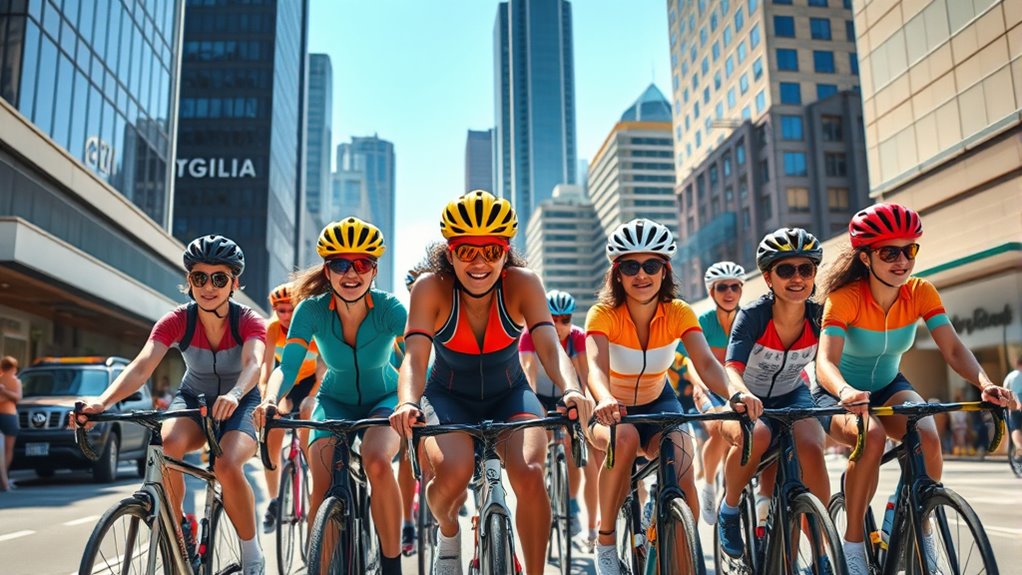
Why does advocating for equal opportunities and resources remain a critical issue for women in cycling? Because gender equity isn’t just about fairness; it directly impacts participation and growth.
Without equitable resource allocation, women face limited access to training, sponsorships, and competitive platforms. You must push for policies that ensure women receive the same support as men, from funding to equipment and race opportunities.
Equal resources are essential for women’s cycling success and growth.
When resources are distributed fairly, it promotes a more inclusive environment and encourages more women to get involved. Advocating for these changes isn’t just about individual athletes; it’s about reshaping the sport’s structure.
Your voice can drive awareness, influence decision-makers, and help create a future where women’s cycling thrives on equal footing.
Celebrating Female Cycling Achievements

Celebrating female cycling achievements highlights the incredible milestones women have reached in the sport.
You’ve likely heard about pioneering cyclists who broke barriers and set new standards. These record-breaking accomplishments inspire others to push limits and chase their own cycling goals.
Pioneering Female Cyclists
Who were the trailblazing women who challenged conventions and paved the way for female cyclists? These pioneering cyclists broke gender barriers and redefined cultural representation within the sport. They fought for gender equity, demanding equal opportunities and recognition in a historically male-dominated arena.
Their efforts inspired others to challenge societal norms and pursue cycling passionately. By pushing boundaries, they demonstrated that women could excel in endurance, speed, and competitive events. Their achievements helped shift public perception, making cycling more inclusive for women everywhere.
These women didn’t just race; they changed perceptions, fostered equality, and created a legacy that continues to inspire generations. Their courage and determination laid the foundation for a more equitable cycling community, ensuring women’s contributions are celebrated and valued.
Record-Breaking Achievements
Throughout history, female cyclists have shattered records and set new standards of excellence, proving that gender is no barrier to extraordinary achievement. From breaking speed records to conquering grueling race courses, these accomplishments highlight how women continue to push boundaries.
Their successes challenge outdated notions of gender parity in sports, inspiring others to pursue greatness. As these feats gain recognition, sponsorship opportunities for women’s cycling grow, providing essential support and visibility.
Your support can help amplify these achievements, encouraging more women to aim higher. Celebrating record-breaking achievements not only honors individual perseverance but also accelerates progress toward equality.
With each record broken, women in cycling demonstrate that determination and talent can defy any obstacle, fostering a future where gender no longer limits potential.
Inspiring the Next Generation of Female Cyclists
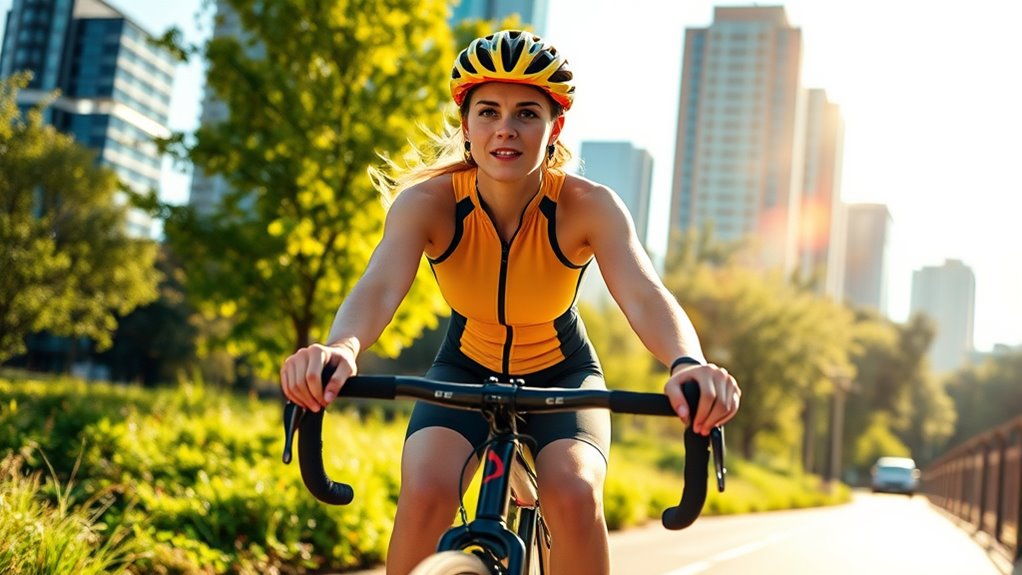
To inspire the next generation of female cyclists, it’s vital to provide young girls with role models and opportunities that showcase their potential in the sport. Highlighting successful women in cycling encourages them to see themselves in similar roles.
Empowering young girls with role models and opportunities inspires future female cyclists to thrive and lead.
Offer access to cycling apparel designed for comfort and confidence, helping girls feel empowered on their bikes. Promoting advances in bike technology, like lightweight frames and easy-to-use gear systems, makes cycling more accessible and enjoyable.
Organizing workshops and youth programs can spark interest early on. When girls see peers and mentors thriving in cycling, they’re more likely to pursue it passionately.
Creating an inclusive environment where their achievements are celebrated will shape a future where women’s cycling continues to grow and inspire new generations.
The Future of Women in Cycling

What does the future hold for women in cycling? You can expect ongoing progress toward gender equity, driven by increased awareness and supportive policies. Technological innovation will play a key role, making bikes lighter, safer, and more customizable for women’s needs.
Imagine a world where:
- Women’s cycling gear is designed with precision and comfort
- Bike frames are tailored to fit diverse body types
- Training apps provide personalized coaching for female athletes
- Virtual races and global communities foster connection
- Sponsorship opportunities grow, boosting visibility and funding
These advancements will empower more women to participate, compete, and lead in the cycling world. With continued effort and innovation, women’s cycling will become more inclusive, dynamic, and inspiring for generations to come.
Frequently Asked Questions
How Can Local Communities Support Women Cyclists More Effectively?
To support women cyclists more effectively, your community can prioritize outreach programs that encourage participation and inclusivity.
Implement safety initiatives like well-maintained bike lanes and awareness campaigns to protect women on the road.
Hosting women-focused cycling events and providing mentorship opportunities also boost confidence.
What Policies Can Promote Gender Equality in Professional Cycling?
You can push for policies like equal prize policies and mentorship programs that truly level the playing field.
Imagine a world where women’s talents are celebrated just as loudly as men’s—that’s possible with strong, enforced gender equality policies.
Advocate for transparent funding, equal opportunities, and supportive mentorship programs that nurture female athletes.
Your voice and action can drive this change, making professional cycling a sport where everyone races on equal ground.
How Do Cultural Differences Influence Women’S Participation in Cycling Worldwide?
You see, cultural perceptions and societal norms greatly shape women’s participation in cycling worldwide. In some cultures, traditional gender roles discourage women from cycling, viewing it as inappropriate or unsafe.
Conversely, supportive norms empower women to ride confidently. By understanding these differences, you can advocate for cultural shifts, promote inclusive attitudes, and create environments where women feel safe and encouraged to participate in cycling irrespective of cultural background.
What Technological Advancements Are Aiding Women Cyclists Today?
Think of technology as the wind beneath your wings, propelling your cycling journey forward. Today, smart gear and wearable tech are revolutionizing your experience by providing real-time data on heart rate, navigation, and performance.
These advancements help you train smarter, stay safe, and boost confidence. With innovations like smart helmets and fitness trackers, you’re empowered to push boundaries and enjoy cycling like never before.
How Can Schools Encourage Girls to Pursue Cycling From a Young Age?
You can encourage girls to pursue cycling from a young age by challenging gender stereotypes and promoting inclusivity. Schools should organize bike programs featuring female role models who inspire confidence and demonstrate that cycling is for everyone.
Providing safe, supportive environments and celebrating girls’ achievements help break down barriers. When girls see relatable role models and are encouraged early, they’re more likely to develop a lifelong passion for cycling.
Conclusion
As you watch women in cycling break barriers like a river carving through rock, remember your power to support and inspire change. Every pedal stroke challenges stereotypes and paves the way for future generations. By embracing diversity and championing equality, you become part of a movement that’s transforming the sport into a more inclusive space—vibrant and unstoppable, like a wildfire fueled by passion and perseverance. Your voice can help shape the future of women in cycling.
